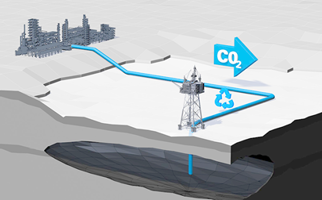
-
The UK needs secure and stable energy supplies, produced as cleanly as possible
-
Industry makes encouraging progress on emissions reductions
-
NSTA committed to holding sector to account on targets
-
Platform electrification vital to surpassing goals
The North Sea oil and gas industry is on track to meet early emissions reduction targets after posting cuts of more than a fifth between 2018-21, according to new analysis.
The latest Emissions Monitoring Report from the North Sea Transition Authority (NSTA) shows that greenhouse gas emissions were cut by an estimated 14.6% to 14.3 million tonnes of CO2e last year, adding up to an overall reduction of 21.5% since 2018.
The report is accompanied by a dashboard which allows the user to conduct a more detailed analysis of emissions performance by UKCS region, year and type of facility, among other variables.
Emissions are a by-product of extracting oil and gas, but industry is working hard to reduce them by investing in more energy-efficient equipment and technologies which minimise flaring.
This action, backed by the NSTA’s robust regulation, a reduction in offshore activity amid the Covid-19 pandemic and the permanent shutdown of several platforms with high emissions contributed to the decreases recorded in recent years.
The large number of platform maintenance shutdowns, timed to coincide with temporary pipeline closures, contributed to a substantial fall in production and associated emissions last year.
Encouragingly, NSTA projections indicate the sector is on track to meet interim emissions reduction targets – of 10% by 2025 and 25% by 2027 – which were agreed in the North Sea Transition Deal (NSTD) between the sector and UK government in 2021.
However, bold measures will be needed to hit the 2030 goal of halving emissions. Upgrading platforms to run on clean electricity, instead of gas or diesel, is essential – the NSTD will not be delivered without it. At least two electrification projects should be commissioned by 2027.
Meeting these NSTD targets is the absolute minimum the NSTA expects from industry, which should strive to surpass them.
The NSTA will continue driving further reductions by robustly managing performance, including through the annual stewardship survey, monitoring and benchmarking, tier reviews and publishing new and updated guidance.
In the first half of 2021, the NSTA started requiring licensees to implement emissions reduction plans for new and existing projects and introduced tough new guidance to clamp down on flaring, the source of more than a fifth of UKCS emissions, and venting.
This has led to impressive actions including the installation of equipment powered by electricity, instead of gas, and systems which capture gas that would otherwise have been flared – contributing to total offshore flared volumes falling by 20% in 2021 and venting by 22% that same year.
Since its revised strategy came into force in February 2021, the NSTA has worked with industry on initiatives which have prevented the emission of 1.2 million tonnes of CO2e, the same as taking more than 500,000 cars off the road for a year.
Dr Andy Samuel, NSTA Chief Executive, said:
“The industry has made impressive progress on reducing emissions during a turbulent period marked by a global pandemic and unprecedented price volatility.
“Energy security is more sharply in focus than ever and the NSTA is working closely with industry and government to bring new oil and gas projects online and bolster UK energy supply. This vital work sits alongside emissions reduction goals.
“The NSTA will continue to hold industry to account to make sure it delivers on, and surpasses, its targets.
“The excellent progress on flaring is another example of our sharp focus on performance combining to good effect with rapid industry action to support emissions reductions and energy security. As a result, flaring has been on a declining trend since 2018 and the reductions achieved in 2021 alone were equivalent to the annual gas demand of 130,000 UK homes.”
Notes to editors:
Read the report here.
The NSTA’s Emissions Monitoring Dashboard can be accessed here.
Combustion for power generation is the main source of emissions with an average of 71%. Flaring follows with 22%. Venting and other non-combustion processes have similar levels with 4% and 3% respectively.
Venting is the discharging of gases into the atmosphere. Flaring is burning the gases before they are discharged and mainly results in CO2 emissions. Both are required for safety and operational reasons, but more can be done to reduce the amount.
For further information please contact:
Tel: 07776 548196


